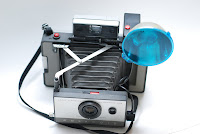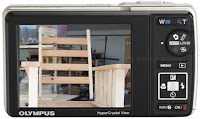Everyone has used a camera to visual document what is happening at a particular moment in time, even if it is just snaps of family and friends.
 What I want to talk about is how many different ways there are of using a camera in the shop, or for woodworking related activities & how digital cameras and camera phones have changed the way we can use pictures. Old school was taking a picture, getting the film developed and pictures printed & then seeing what you have - with some chance of repeatable results through reprinting using the negatives / enlarging and printing details of a snapped photo. Polaroid technology gave us instant results - and the only chance at repeatabilty was from viewing the resulting picture and re-taking a better shot.
What I want to talk about is how many different ways there are of using a camera in the shop, or for woodworking related activities & how digital cameras and camera phones have changed the way we can use pictures. Old school was taking a picture, getting the film developed and pictures printed & then seeing what you have - with some chance of repeatable results through reprinting using the negatives / enlarging and printing details of a snapped photo. Polaroid technology gave us instant results - and the only chance at repeatabilty was from viewing the resulting picture and re-taking a better shot. Digital camera technology, whether in a discrete camera, a cellphone camera, or even in a device family that started out as a music player and continues to add features has the best of all worlds - an instant look at the image you've captured and the ability to edit an image in endless ways after the fact before you print it - if you ever do. Frankly I rarely print pictures anymore.
 Regardless of the history lesson, for most people, film cameras of any sort are dead, so I will be focusing on the use of a digital camera / camera phone for woodworking purposes. Sure, there are still plenty of people getting film developed, but when a serviceable point and shoot 5mp camera costs less than developing and printing costs of 6 rolls of film I have a hard time understanding why. Shrug. Dismounts soapbox.
Regardless of the history lesson, for most people, film cameras of any sort are dead, so I will be focusing on the use of a digital camera / camera phone for woodworking purposes. Sure, there are still plenty of people getting film developed, but when a serviceable point and shoot 5mp camera costs less than developing and printing costs of 6 rolls of film I have a hard time understanding why. Shrug. Dismounts soapbox.Most of these tips are of course usable for more than just woodworking, but if I didn't limit the focus of this blog, it would be pretty random!
- First, there is the act of recording your work - even if it is just for yourself, a good photographic record will keep things crystal clear, long after your memory has faded. Howard Ruttan said it best, here and has plenty of good "how to" tips, too.
- Take pictures of products / product barcodes instead of hand written notes when going to the store to buy more - I've found this especially helpful when buying cans of finish, where you need to buy more of exactly the same stuff, but don't want to drag the entire can with you - I use the camera on my cellphone for this and don't bother printing - I just view the image on screen. Can price shop this way too - take a picture of the product barcode and price tag, and use the info to shop for a better deal after you leave the store.
- Take pictures of furniture / ideas that you really like that inspires you. I've done this with fellow craftsman's work (with their permission) and at furniture stores (well, I've never been asked to stop.) When I see something I really like or want to duplicate or make my own version of, I take a quick snap. I keep a folder of images on my computer full of pretty furniture - and details of furniture I particularly like.
- Decide on finish - depending on what image editing / manipulation software you use, you can take a picture of an unfinished piece and can play with color digitally before committing yourself.
- Use a cropped digital image in a Google Sketchup drawing to see if it is what you / you client wants - as long as the angle you take the photo at is appropriate to the view you eventually want to look at, Sketchup is quite accomodating - simply align the drawing to the image. You can do it the other way too - take a picture of the wall a built-in or any other piece is going to be against, and position your Sketchup model against it. Get the sizing just right, then use relative measurements to perfectly size the piece you are making.
- Tool repair - any sort of complicated dis-assembly can benefit from pictures along the way to aid in re-assembly. Actually, this tip is what caused me to write this entire post - was about to strip laces out of a pair of shoes preparatory to tossing them in the washer & out of habit took a picture of the way they were laced, so I could re-lace exactly the same way.
- Using a camera as a magnifying glass - when working on something tiny, a camera that has a good zoom feature that works well in low light situations can help you without even needing to take a picture - just use it as a really expensive combination lamp and magnifying glass, or snap a picture with flash to see around corners / into dark, awkward or tight spaces.
- Take pictures at auction previews, estate and garage sales - or any other buying situation, including wood purchases. This is where a cellphone camera shines - especially if you see something someone else can use - email or message the picture and get an answer back immediately rather than attempting to describe.
Well, that about wraps it up - oh, one final tip - as soon as humanly possible, give your image a meaningful file name. DSC00190.jpg doesn't convey any useful information. If you like keeping the sequence number, why not rename it to:
"DSC00190 Stickley Recliner Final Dry Fit view from front.jpg" ?
Yep, nothing wrong with spaces in filenames, and it makes searching for the image you want much easier. If you manipulate images a lot, consider adding suffixes such as the date, and if you've resized it from the original, note that too. So your final filename for a version you plan to post on the web or send in an email might be:
"Stickley Recliner Final Dry Fit view from front 2009 September 19 800x600.jpg"
Yep, I leave the sequence number off, and simply use the sort order to group pictures in the same series, or I add my own sequence number:
"Stickley Recliner 001 Grain selection for parts 2009 September 07.jpg"
...so that even if I want basically the same filename for the next 5 shots, the rest of the pictures in the sequence (002, 003, etc.) are still unique. I leave date at end so that even if a particular group of pictures span a few days, they will still be grouped together. But really, what ever works for you is perfect.
畫意能達萬言
A Picture's Meaning Can Express Ten Thousand Words.


No comments:
Post a Comment